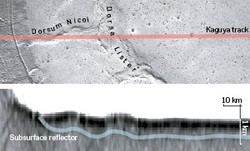Radar measurements penetrating beneath the moon's surface suggest that surface ridges were formed when the moon cooled and shrank

Fig. 1: Radar reflections (blue) indicate that subsurface rock boundaries have similar shapes to ridges (Dorsa Lister and Dorsum Nicol) on the moon's surface.
From Ref. 1. Reproduced with permission. c 2010 AAAS
Although man walked on the moon over 40 years ago, many questions about Earth's only natural satellite remain unanswered. For example, scientists do not completely understand how the moon acquired large flat plains covered in volcanic rock, called 'maria', or why these plains are more common on the near side of the moon. Understanding the formation of maria, which can be seen from Earth as dark regions across the moon surface, would shed light on how the moon itself was formed and evolved. Yasushi Yamaguchi from Nagoya University's GCOE for Earth and Environmental Science along with colleagues from Tohoku, Nagoya, Kyoto and Kanazawa universities in Japan and the Korea Institute of Geoscience and Mineral Resources have now discovered evidence linking mare formation to the cooling of the moon1. The researchers used data from the Japanese Kaguya spacecraft, which orbited the moon for twenty months between 2007 and 2009. The Kaguya took radar readings that probed deep into the lunar surface. Similar radar surveys were performed during the Apollo missions in the 1970s, but the Kaguya scanned a much larger area, and with the aid of modern signal processing techniques delivered much greater detail. The Japanese and earlier American radar surveys observed reflectors beneath the surface probably caused by boundaries between basaltic lava and other material. However, the Kaguya revealed that these reflectors are much shallower than indicated by the Apollo measurements. And the better detail of the Kaguya survey revealed that the reflectors closely follow the shapes of ridges on the mare surface (Fig. 1). These findings are inconsistent with previous theories about mare formation, which suggest that the surface ridges emerged as lava layers that formed and settled under their own weight. Such a process would produce ridge shapes that differ from the shape of the deep subsurface layers. The similarity between the subsurface reflector measured by the Kaguya and the shapes of overlying ridges suggest instead that the surface ridges were formed by horizontal compression. Such a compression event could have been caused by the cooling and consequent shrinking of the moon after its formation. The moon presents a unique opportunity to collect such data because, unlike other bodies like Mars and Earth, its surface has been relatively unaffected by erosion and weathering. By placing new constraints on models of lunar cooling, the Kaguya data could influence our understanding of how planets and satellites form. "I believe that radar sounding will become a popular method in future exploration projects," says Yamaguchi.
Affiliated Researchers
The Nagoya University affiliated researchers mentioned in this highlight are from the From Earth System Science to Basic and Clinical Environmental Studies (BCES) GCOE program of the Graduate School of Environmental Studies.
Reference
- Ono, T., Kumamoto, A., Nakagawa, H., Yamaguchi, Y., Oshigami, S., Yamaji, A., Kobayashi, T., Kasahara, Y., & Oya, H. Lunar radar sounder observations of subsurface layers under the nearside maria of the Moon. Science 323, 909-912 (2009). | article